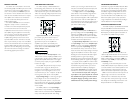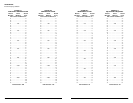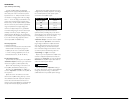
out of the preamp outputs of the amplifier are
compatible with the “Low” setting on the
“Input Range” control.
The “Signal Sensing” turn-on feature will not
work on “slave” amplifiers, but “slave” amplifiers
can be turned on and off by a “master” amplifier
operating in signal sensing turn-on mode.
Simply connect the “master” amplifier’s
“Remote” connection, to the “slave” amplifier(s)
“Remote” connection(s).
Do not increase the “Input Sens.”setting for any
amplifier in the system beyond the maximum level
established during the procedure outlined in
Appendix B (page 14). Doing so will result in
audible distortion and possible speaker damage.
4) If you would like to run a third amplifier in
“Slave” configuration, select the “Full-Range”
position on the “Output Mode” switch of the first
“Slave” amplifier.Then, connect an RCA cable
from the first “Slave” amplifier’s preamp outputs to
the second “Slave” amplifier. As you did with the
first “Slave” amplifier, set the second “Slave”
amplifier’s “Amp LP Filter” to the “Off” position.
Then, calibrate the third amplifier’s “Input Range”
and “Input Sens.” controls in the same manner as
you did for the second amplifier.
Additional amplifiers may be added to this
“Master/Slave” configuration following the same
procedure as in step 4.
Once you match the input sensitivities of all the
amplifiers, you can use the “Master” amplifier’s
“Amp LP Filter” and “Advanced Bass Control”
features to control the “Slave” amplifier(s). If the
remote bass control (RBC-1) is used, it need only
be connected to the “Master” amplifier to control
all the amplifiers in the Master/Slave chain.
Below is a diagram showing a Master/Slave
configuration with one “Master” (top amplifier)
and two “Slave” amplifiers. Switches and controls
that are defeated in the “Slave” amplifiers are
printed in gray.
JL AUDIO 1000/1 17
Low/High
Low/High
Low/High
Connect Master 1000/1 Preamp Output to Slave A 1000/1 Input
Connect Slave A 1000/1 Preamp Output to Slave B 1000/1 Input
Connect Master 1000/1 Input to Signal Source
+12VDC Ground Remote
+12VDC Ground Remote
+12VDC Ground Remote
IMPORTANT
!
Set all amps in chain to "Normal" OR
Set all amps in chain to "Reversed"
Make sure that the "Output Polarity"
switches are in the same position for
all the amplifiers in a master/slave chain.
APPENDIX C:
Master/Slave Configurations
With the flexible on-board crossovers and
processing incorporated into the 1000/1, it is
possible to connect multiple 1000/1’s in a
“Master/Slave” configuration, with each amplifier
driving its own speaker system but controlled by
the processing and filtering of only one amplifier.
This is very useful when driving multiple
subwoofers with multiple amplifiers.
To create a Master/Slave configuration, first
determine which amplifier will be the “Master”
amplifier and connect the main input signal to that
amplifier (from the source unit or from an
outboard processor).This amplifier’s “Amp LP
Filter” section and “Advanced Bass Control”
features will process the signal for the “Slave”
amplifier or amplifiers.
Here is the procedure for implementing a
“Master/Slave” configuration:
1) Set the “Master” amplifier’s “Output Mode”
switch to the center “Amp Filter” position.This will
send a parallel, mono-summed signal from the
“Master” amplifier’s “Amp LP Filter” section to its
preamp outputs.
2) Connect an RCA cable from the “Master”
amplifier’s preamp outputs to the main input of the
first “Slave” amplifier. Set the “Slave” amplifier’s
“Amp LP Filter” to the “Off” position.This will
defeat the LP filter and the bass processing of this
“Slave Amplifier”.
3)The input sensitivity of the two amplifiers
needs to be adjusted independently.To properly
calibrate the amplifiers for maximum, identical, clean
output, please refer to Appendix B (page 14).
After using this procedure, you can then adjust the
level of the amplifiers by adjusting the input
sensitivities downward, if the amplifiers require
attenuation to achieve the desired system balance.
If the input sensitivities are adjusted, the amplifiers
must be recalibrated to ensure identical power
output levels.
Please note that the “Input Range” switch on
all “slave” amplifiers needs to be set to “Low”,
even if the “master” amplifier is high voltage and
its switch is set to “High”.All signals passed
16 JL AUDIO 1000/1
The Master amplifier’s
“Advanced Bass Control”
section is active and affects
all three amplifiers equally.
The last Slave amplifier’s
“Advanced Bass Control”
section,AMP LP Filter and
“Preamp Output” are inactive.
This Slave amplifier’s
“Advanced Bass Control”
section and AMP LP Filter are
inactive, but the Full-Range
(pass-through) feature of its
“Preamp Output” feeds the
input of the next Slave amplifier.
SLAVE (B):
MASTER:
SLAVE (A):















